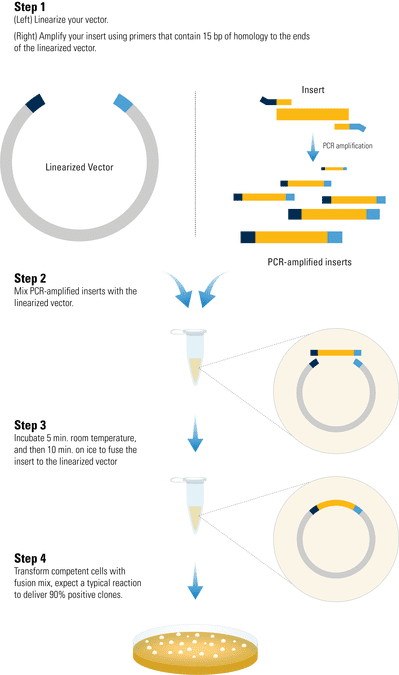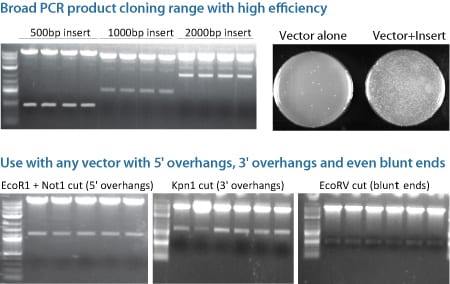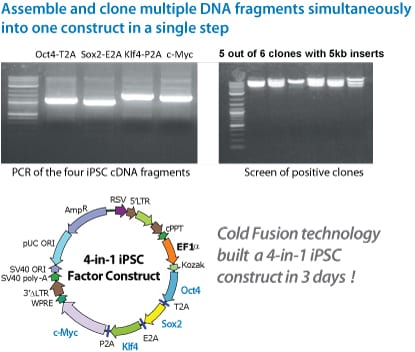Cold Fusion Cloning Kit with Competent Cells
- Fast—get transformation-ready DNA in as little as twenty minutes
- Easy—a phosphatase-free and ligation-free system that eliminates the need for specific restriction enzymes
- Efficient—typically achieve >90% positive clones
- Versatile—add any insert into any site in any vector using manual or automated workflows
Products
| Catalog Number | Description | Size | Price | Quantity | Add to Cart | |||
|---|---|---|---|---|---|---|---|---|
| MC010B-1 | Cold Fusion Cloning Kit with Competent Cells | 10 Reactions | $388 |
|
||||
| MC096B-1 | Cold Fusion Cloning Kit with Competent Cells - 96-well format | 96 Reactions | $2721 |
|
||||
| MC100B-1 | Cold Fusion Cloning Kit with Competent Cells | 20 Reactions | $707 |
|
||||
| MC101B-1 | Cold Fusion Cloning Kit with Competent Cells | 50 Reactions | $1555 |
|
||||
Overview
Overview
Quick and easy ligation-free cloning
Fast, easy, and efficient, SBI’s Cold Fusion Cloning is an excellent choice for any cloning project. Whether you're assembling multiple fragments of DNA or simply adding an insert or gBlock® to a vector, the Cold Fusion Cloning Kit will take you to transformation-ready DNA in a single step—just incubate your DNA fragment(s) with linearized vector for five minutes at room temperature and ten minutes on ice. A typical cloning reaction will deliver a successful cloning rate of more than 90%.
- Fast—get transformation-ready DNA in as little as twenty minutes
- Easy—a phosphatase-free and ligation-free system that eliminates the need for specific restriction enzymes
- Efficient—typically achieve >90% positive clones
- Versatile—add any insert into any site in any vector using manual or automated workflows
“I have designed and made hundreds and hundreds of clones using the traditional and not so traditional methods since I started doing research. I must say the Cold Fusion kit makes it way too easy to design a vector or new construct—it’s a really good product.”
~Hidevaldo B. Machado, PhD., UCLA
References
How It Works
How It Works
Streamlining vector construction with Cold Fusion Cloning
Cold Fusion Cloning is a quick and easy way to place an insert—or multiple inserts simultaneously—into a linearized vector. The Cold Fusion Master mix contains a proprietary blend of enzymes that prepares DNA fragments ends for sequence-directed alignment. Homologous DNA ends are efficiently fused together and produce vector clones with great accuracy.
The four-step process is as follows (see workflow illustration below):
- Linearize your vector and amplify your insert using primers with at least 15 bp of homology to the ends of your linearized vector.
- Mix your PCR-amplified inserts with the linearized vector.
- Incubate for 5 minutes at room temperature and then 10 minutes on ice to fuse the insert to the linearized vector.
- Transform competent cells with the fusion mix. A typical Cold Fusion Cloning reaction delivers 90% positive clones.
Supporting Data
Supporting Data
See the results of a better way to clone
Figure 1. Cold Fusion Cloning can clone 3′, 5′, and blunt-end fragments efficiently.
Figure 2. Simultaneously insert multiple fragments into a vector in a defined order. Using Cold Fusion technology, the team at SBI built a 4-in-1 construct to generate iPSCs in only three days.
FAQs
Documentation
Citations
Related Products
Products
| Catalog Number | Description | Size | Price | Quantity | Add to Cart | |||
|---|---|---|---|---|---|---|---|---|
| MC010B-1 | Cold Fusion Cloning Kit with Competent Cells | 10 Reactions | $388 |
|
||||
| MC096B-1 | Cold Fusion Cloning Kit with Competent Cells - 96-well format | 96 Reactions | $2721 |
|
||||
| MC100B-1 | Cold Fusion Cloning Kit with Competent Cells | 20 Reactions | $707 |
|
||||
| MC101B-1 | Cold Fusion Cloning Kit with Competent Cells | 50 Reactions | $1555 |
|
||||
Overview
Overview
Quick and easy ligation-free cloning
Fast, easy, and efficient, SBI’s Cold Fusion Cloning is an excellent choice for any cloning project. Whether you're assembling multiple fragments of DNA or simply adding an insert or gBlock® to a vector, the Cold Fusion Cloning Kit will take you to transformation-ready DNA in a single step—just incubate your DNA fragment(s) with linearized vector for five minutes at room temperature and ten minutes on ice. A typical cloning reaction will deliver a successful cloning rate of more than 90%.
- Fast—get transformation-ready DNA in as little as twenty minutes
- Easy—a phosphatase-free and ligation-free system that eliminates the need for specific restriction enzymes
- Efficient—typically achieve >90% positive clones
- Versatile—add any insert into any site in any vector using manual or automated workflows
“I have designed and made hundreds and hundreds of clones using the traditional and not so traditional methods since I started doing research. I must say the Cold Fusion kit makes it way too easy to design a vector or new construct—it’s a really good product.”
~Hidevaldo B. Machado, PhD., UCLA
References
How It Works
How It Works
Streamlining vector construction with Cold Fusion Cloning
Cold Fusion Cloning is a quick and easy way to place an insert—or multiple inserts simultaneously—into a linearized vector. The Cold Fusion Master mix contains a proprietary blend of enzymes that prepares DNA fragments ends for sequence-directed alignment. Homologous DNA ends are efficiently fused together and produce vector clones with great accuracy.
The four-step process is as follows (see workflow illustration below):
- Linearize your vector and amplify your insert using primers with at least 15 bp of homology to the ends of your linearized vector.
- Mix your PCR-amplified inserts with the linearized vector.
- Incubate for 5 minutes at room temperature and then 10 minutes on ice to fuse the insert to the linearized vector.
- Transform competent cells with the fusion mix. A typical Cold Fusion Cloning reaction delivers 90% positive clones.
Supporting Data
Supporting Data
See the results of a better way to clone
Figure 1. Cold Fusion Cloning can clone 3′, 5′, and blunt-end fragments efficiently.
Figure 2. Simultaneously insert multiple fragments into a vector in a defined order. Using Cold Fusion technology, the team at SBI built a 4-in-1 construct to generate iPSCs in only three days.




